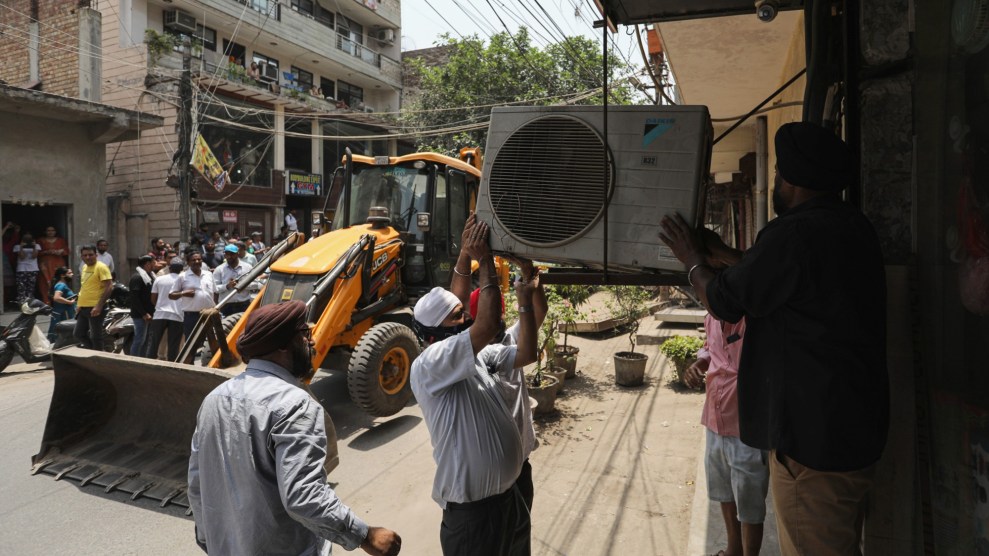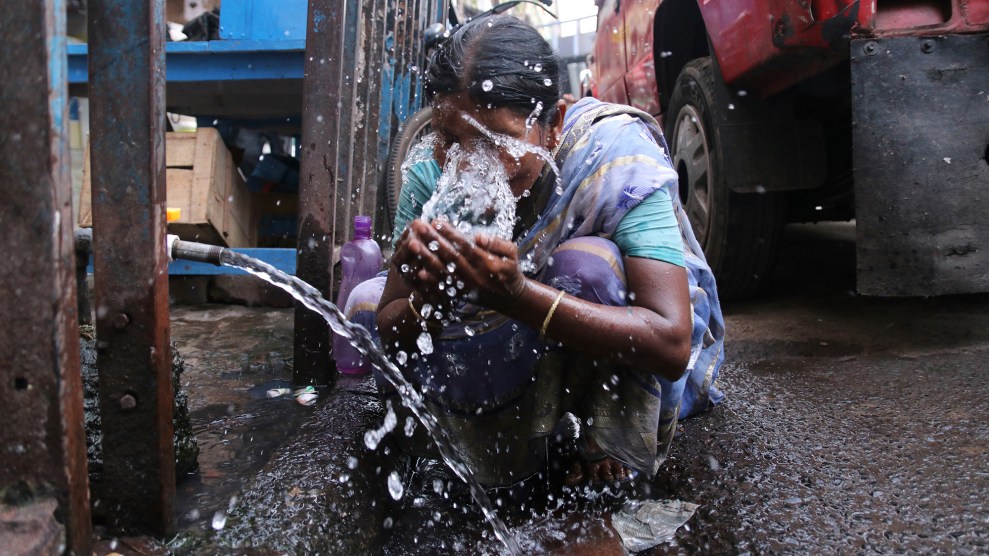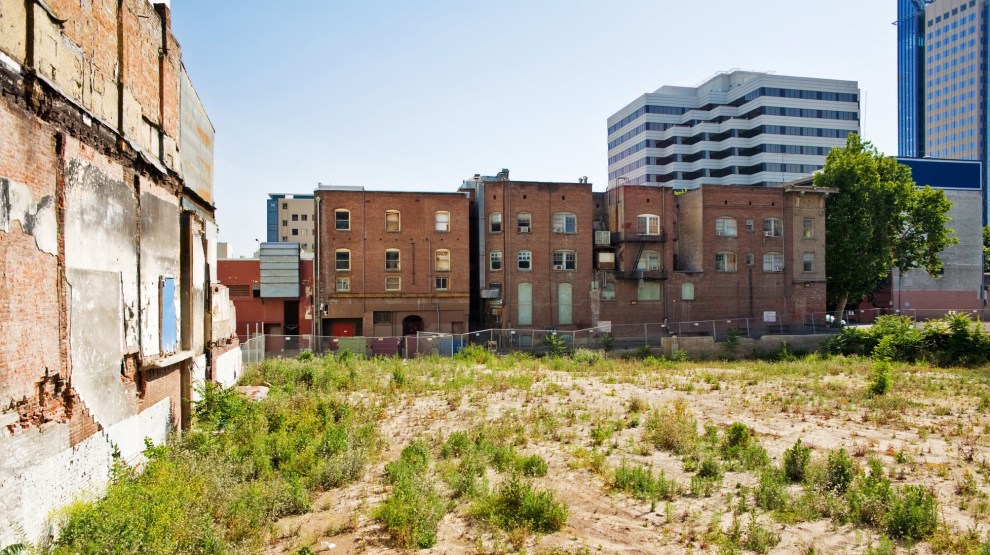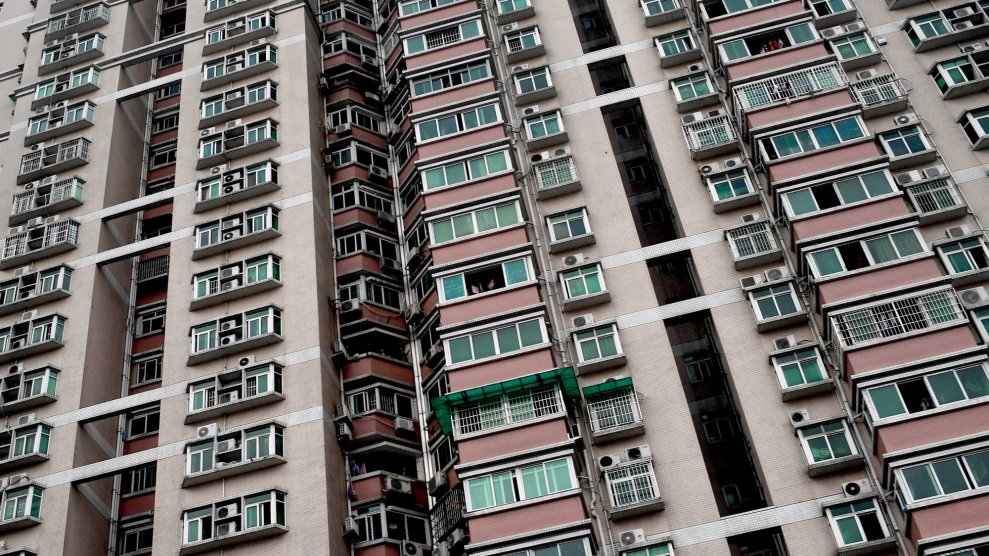
Men remove an air conditioner in advance of a building demolition in New Delhi.Naveen Sharma/Zuma
This story was originally published by the Guardian and appears here as part of the Climate Desk collaboration.
For Muskan, the arrival of summer in Delhi is the “beginning of hell.” As temperatures in her cramped, densely populated east Delhi neighborhood often soar above 45C (113F), she dreams of only one thing: air conditioning.
During the day, in the tiny, windowless kitchen where she cooks for her family, she often feels like she will collapse from the heat and her health deteriorates. Nights are even more painful. Sleep becomes almost impossible in their single-room apartment.
Her three children, sticky and uncomfortable, cry out begging to be cooled down, and she wakes every five minutes to douse them and herself with cold water and wet scarves. The single fan hanging from the flaking yellow ceiling does little to ease their woes and the putrid stench from the sewage and festering rubbish means opening a window is impossible. In any case, as she points out: “It’s usually even hotter outside.”
In her previous marriage, the 30-year-old had tasted the sweet relief of air conditioning in Delhi’s increasingly blistering summers. But after her husband died, her family remarried her to a scrap dealer, whose earnings are barely enough to pay for rent and food. The costs involved in renting or buying an air conditioner are far beyond their means, yet she fears for her family without one.
“I can’t keep seeing my children suffer like this,” she says. “I keep promising that next summer we will get an AC but the reality is I know we can’t afford it. But as more and more people around us buy ACs, the hotter it gets outside. Soon, I don’t know how we will survive.”
India’s market for ACs is growing faster than almost anywhere else in the world. A mixture of rising incomes, rising temperatures in an already hot and humid climate and increasing affordability and access are driving more and more Indians towards buying or renting one as soon as they can afford it—and sometimes even when they cannot.
Between 8 percent and 10 percent of the country’s 300 million households—home to 1.4 billion people—have an AC, but that number is expected to hit close to 50 percent by 2037, according to government projections. A report by the International Energy Agency (IEA) predicts that by 2050, India will have more than 1 billion ACs in operation.
Vaibhav Chaturvedi, a fellow at the council on energy, environment and water, a Delhi think tank, was among those who believed AC penetration would exceed all current predictions.
“Traditionally, air conditioning was viewed as a luxury commodity but not any more,” he said. “It is seen as a necessity to survive. The way the market is developing, it could be that 100 percent of households have AC by 2050.”
Others are more skeptical that ACs will become so widespread among India’s poor people, and have raised concerns that access to sufficient cooling, particularly to work, sleep and stay healthy, could drive up the already rampant inequality in the country even further.
The problem of keeping cool in increasingly hotter temperatures—while not exacerbating the climate crisis in the process—is not India’s alone. Globally, AC numbers have increased to more than two billion. More than 20 percent of all the world’s electricity is used by fans or ACs, a proportion that is expected to soar further in coming years.
It could have significant implications for the global effort to keep temperature rises within 1.5C. Around the world, ACs are still largely inefficient and use a huge amount of electricity mostly generated by fossil fuels.
En masse, they can drive up outside temperatures as they pump out heat from indoors to outdoors. They contain chemical refrigerants which, if leaked, can be almost 1,500 times more environmentally destructive than CO2.
At this year’s UN Cop28 climate summit, which is taking place in Dubai, the issue will be at the forefront of discussions as some of the world’s largest economies have signed up to the first ever global cooling pledge, led by the UN environment programme.
So far, more than 50 signatories have signed on to cut their cooling emissions by 68 percent by 2050. India, however, is not expected to join.
There is little doubt in the minds of experts and citizens that India’s need for ACs is both essential and unstoppable. March 2022 was the hottest since 1901 and there were more than 200 heatwave days across the whole year. This February was the hottest in 122 years and in June a deadly heatwave in the states of Uttar Pradesh and Bihar killed at least 100 people, which is probably a radical undercount.
In July, during the pre-monsoon humidity in Delhi the wet bulb temperature hit a record high of 30C—when it hits 35C, the human body, no matter how healthy, can not survive for more than a few hours as it can no longer cool itself down.
Experts commonly point to “cooling degree days” to demonstrate India’s overwhelming—and largely unmet—requirement for cooling: a figure calculated by the number of hours in a day that temperatures go above 18C.
By this calculation, India has more than 3,000 cooling degree days per year, one of the highest in the world. If applied to all 1.4 billion people in the country, it comes to more than 3tn annually—a figure four times higher than China and five times higher than the US.
“People are going to buy ACs, that’s a given,” says Satish Kumar, president and executive director of the Alliance for an Energy Efficient Economy.
“The latent demand for cooling is massive. What we have to focus on is how to chart a more sustainable and energy efficient path, one where air conditioning is not the be all and end all solution.”
Extreme heat is particularly problematic in cities such as Delhi, home to 32 million people, where the number of hot days is expected to increase by 33 percent, heatwaves will be 30 times more likely and overall temperatures could rise by as much as 5C. By 2028, it will also become the most populous city on the planet, according to UN projections.
A phenomenon known as “urban heat islands” has already emerged across India’s capital. Here, surfaces of homes, roads and rooftops are predominantly covered with concrete, brick, steel and tarmac, which absorb and trap the heat. Homes are often high-rise buildings packed tightly together and there are few trees to provide shade.
With an increasing number of ACs also belching out hot air into these confined, unventilated urban areas, temperatures sometimes rise 6C above the city average.
In the congested alleyways of old Delhi, in a neighborhood known as Chandni Chowk, historically people have had ways of adapting to Delhi’s hot summers. Kamla, 65, a chai seller, lives in a traditional courtyard home, about a century old, which has thick walls to keep the inside cool, as well as several terraces and an outdoor kitchen for ventilation. Though Chandni Chowk is deemed an urban heat island, and often becomes one of the hottest places in Delhi, in the hot summer months Kamla and her children and grandchildren rely only on a single fan and sleep outside at night.
“AC is not a necessity for me, I have lived with this heat all my life” she says. “It is difficult but it is life. But people are different now, they can’t bear the summers for even a few days. I have seen many people are buying ACs as a status symbol even when they can’t afford it.”














